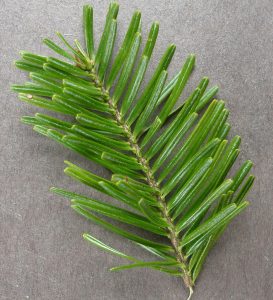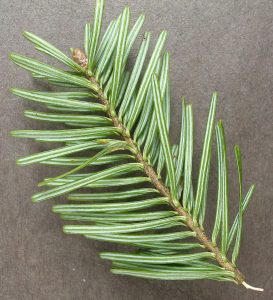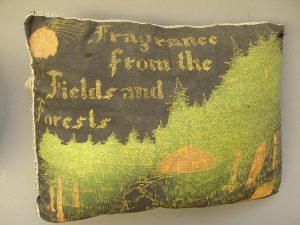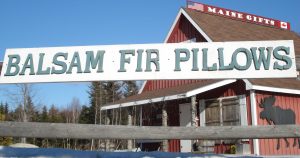Bulletin #2541, Maine Balsam Fir: A Tree of Many Uses, Abies balsamea
Pohpóhkhαwih (Penobscot)
(Penobscot)
Puhpukhawihqimus (Passamaquoddy-Maliseet)
Stoqon (Micmac)
By David Fuller, Extension Agriculture and Non-Timber Forest Products Professional, University of Maine Cooperative Extension.
For information about UMaine Extension programs and resources, visit extension.umaine.edu.
Find more of our publications and books at extension.umaine.edu/publications/.
A tree of many uses
Balsam fir is a conifer tree species of significant economic importance in Maine, and its products have many applications. Primary uses for the mature tree and its wood are for dimensional lumber, such as two-by-fours, and for pulp in papermaking. But balsam fir has many non-timber uses that enable landowners, and those with access to the resource, to derive additional benefit from the tree before it reaches timber or pulp-harvesting size.
Importance to Maine’s economy
Although there are no firm figures on the production of balsam fir wreaths and other seasonal decorations in Maine, it is known that many hundreds of people are employed in wholesale and retail balsam fir decoration businesses in Maine. Current estimates place the value of non-timber balsam fir products in Maine at $25 million. Maine fir products are shipped all over the country, and Maine wreaths are even used at Arlington National Cemetery to honor those who have served in the United States Armed Forces. The manufacture of balsam fir products is a good example of a cottage industry that requires little in start-up costs, although a good business and marketing plan may still be necessary for success. (For more information see Bulletin #3005, Your Business Plan, A Fact Sheet for Small-Scale Business Owners.
Identification
Balsam fir leaves, or needles, are flattened and measure from one-half to one inch long. Sometimes they are finely notched at the tip. Mature needles are dark green and shiny on the top and have two parallel stripes on the underside running the length of the leaf. The needles grow primarily from the sides of the twigs, which appear flattened in the shade, and appear more fully rounded when growing in full sun.
- Shiny, dark green needles grow from the sides of the twigs in two single rows on either side of the branches. Photo by D. Fuller.
- Look for parallel stripes on the underside of the needles. Photo by D. Fuller.
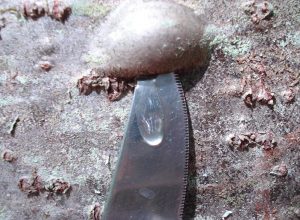
The bark of balsam fir is gray, relatively smooth, and has pitch or resin blisters containing a thick, very fragrant resin. The bark of older trees sometimes lacks blisters and can take on a rough appearance.
Cones are found in the tops of balsam fir trees. The dark purple (maturing brown) cones are borne upright and measure from two to four inches long. Mature cones fall apart while still on the tree — the winged seed falls either with the cone scales or alone and is spread by the wind.
Balsam fir is a relatively short-lived tree, growing to 60 to 70 feet in height and 12 to 20 inches in diameter.
Distribution
Balsam fir can be found throughout Maine, but it is more heavily concentrated in Washington County, where many of Maine’s larger wreath businesses are located, as well as in northern Maine
Non-timber forest product uses
-

Table centerpiece. Holiday decorations
The most common non-timber forest product use of balsam fir is the making of holiday decorations from its branches. Such decorations include wreaths, swags, garland, kissing balls, doorway arches, grave blankets, table centerpieces, and floral decorations.
- Balsam fir pillows
Needles and small-diameter branches are ground or chipped and dried, and used in the manufacture of balsam fir pillows. Balsam fir pillows, as well as other items known as “fancy goods,” were made in Maine as early as the 1870s by Shaker women in New Gloucester for sale to tourists. Maine-made fir pillows continue to be a favorite tourist gift owing to the enduring smell of Maine woods balsam fir, which may last a decade or more.
- Balsam fir pillow.
- Maine gift shop and sign.
- Weather sticks
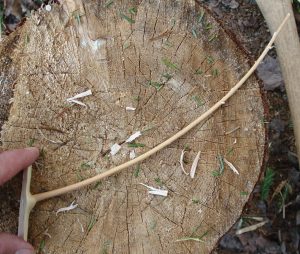
Balsam fir weather stick. Weather sticks are mounted outdoors to predict approaching weather changes by dipping up for fair weather or down for precipitation. They are typically made from the small branches of balsam fir harvested in the spring, when the bark peels readily. Weather sticks were traditionally used in Maine lumber camps.
- Resin
Harry Davis, the “Spruce Gum King” of Monson, Maine, was a significant supplier of balsam fir resin for the United States Armed Forces during World War II. The resin was used as transparent cement in gun sights and other optical equipment. Balsam fir resin has also been used to fix cover slips for prepared microscope slides, as an ingredient in varnish, and as a fragrance source. Balsam fir resin is an ingredient in a commercial cold medicine and has been used historically in Maine by Native Americans for a variety of ailments. Balsam fir resin is also known as Canada balsam, and industry for its collection and sale exists in the Province of Quebec, not far from the Maine border.
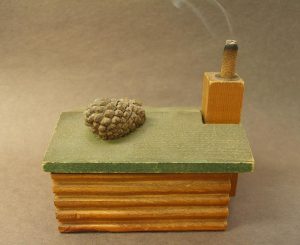
- IncenseGround balsam fir needles are also used to make incense. Maine has had a balsam fir incense industry since at least 1931.
- Christmas trees
Balsam fir is the leading Christmas tree in Maine, noted for its fragrance and ability to retain its needles. While many acres are commonly planted for Christmas tree production, naturally occurring balsam fir regrowth on harvested woodlands can also be managed for Christmas tree production, especially where the soils and site are favorable for the species.
Markets
Maine balsam fir products are currently marketed through the Internet, mail-order catalogs, in gift shops, at farmer’s markets, through craft fairs, and at roadside stands. They are also sold wholesale. In recent years, holiday decorations made from West-Coast evergreens have appeared in markets in Maine, but they lack the distinctive and long-lasting fragrance of balsam fir.
The market price of balsam fir increases dramatically with the degree that value is added. For example, the four pounds of balsam fir brush needed to make a 24-inch diameter wreath sells wholesale for about $2, while that finished, undecorated wreath sells for $6 to $8. The same wreath, decorated, can retail from $12 to $30 or more, depending on the degree and quality of decorations used.
For more information on balsam fir wreaths and sustainable harvest of balsam fir, see the following bulletins from the University of Maine Cooperative Extension:
- Bulletin #7011, Balsam Fir Tip Harvesting
- Bulletin #7012, Making Balsam Fir Wreaths
- Bulletin #7089, Growing a Continuous Supply of Balsam Fir Wreath Brush
Special thanks to our reviewers:
- Kevin Doran, Natural Science Educator, Maine Forest Service
- Julie Miedtke, Extension Educator, Forestry Program, University of Minnesota
- Dave Rochester, District Forester, Maine Forest Service
Information in this publication is provided purely for educational purposes. No responsibility is assumed for any problems associated with the use of products or services mentioned. No endorsement of products or companies is intended, nor is criticism of unnamed products or companies implied.
© 2012, 2015
Call 800.287.0274 (in Maine), or 207.581.3188, for information on publications and program offerings from University of Maine Cooperative Extension, or visit extension.umaine.edu.
The University of Maine is an EEO/AA employer, and does not discriminate on the grounds of race, color, religion, sex, sexual orientation, transgender status, gender expression, national origin, citizenship status, age, disability, genetic information or veteran’s status in employment, education, and all other programs and activities. The following person has been designated to handle inquiries regarding non-discrimination policies: Sarah E. Harebo, Director of Equal Opportunity, 101 North Stevens Hall, University of Maine, Orono, ME 04469-5754, 207.581.1226, TTY 711 (Maine Relay System).


